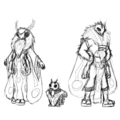Mothfolk: Difference between revisions
| Line 192: | Line 192: | ||
Image:Mothfolk_3.png | Image:Mothfolk_3.png | ||
Image:Mothfolk_4.jpg | Image:Mothfolk_4.jpg | ||
Image:Mothfolk_5.jpg | |||
Image:Mothfolk_6.jpg | |||
Image:Mothfolk_7.jpg | |||
Image:Mothfolk_8.jpg | |||
</gallery> | </gallery> | ||
Revision as of 20:45, 14 August 2014
History
The Mothfolk, or mothkin, are the spawn of the fey queen Cimre. Cimre was queen of Dusk, who longed eternally for the dawn. Cimre waited at the horizon for the Sun to rise, and the two collided. From Cimre's wings several feathers fell, landing in the trees below. These were the first mothkin.
Early Society
The earliest mothkin gathered together into a large colony, the first of their cities. Houses were built among the branches of the great trees of the eastern forests, and they developed language and soon after writing. There were no true leaders in the earliest days, and mothkin society was isolated and naive. They wove tales of the fey that the were still connected to, but knew nothing of other races. Vigils were held nightly to the moon, in reverence for their mother Cimre of the Dusk. This peaceful reality was shattered, however, upon the arrival of one Baloth Ironchin. Baloth was a dwarven miner, and leader of a band of dwarves who had been cast out from their mountain home for reasons unexplained. He was the first non-fey to set eyes on the mothkin, and he saw not beauty and innocence, bit fragility and ignorance. Baloth' s dwarves marched into their woods, and the mothkin, having never seen such creatures, stood in wonder and fear. But the dwarves hated the fey, and Baloth's zealotry overwhelmed him. Ten dozen dwarves rampaged through the forest, killing those they could and sacking the towns. Over two hundred mothkin were slain, but Baloth finally departed. From that day, the mothkin knew only hatred for dwarvenkind.
Beginnings of the Daimyos
Scarred by the unprecedented and wholly alien act of violence against them, the mothkin resolved firstly to rebuild. Houses were reconstructed, the forest healed, and new generations of mothkin raised into a different life than their forefathers.
Around this time of reconstruction did the Church of the Flame develop. To its first practitioners, the fire would cleanse them of their past naivete, and reforge their connection to the fey that had guided them. Among their ranks came one known simply as Tanji. He preached words of revitalization and hope to the mothkin, and was claimed to be an emissary of Cimre herself.The mothkin finally had a leader, and they named him Daimyo.
With their city rebuilt (with walls and palisades, for better defense), Tanji gave a new goal to the mothkin, an order issued at the end of the twilight days that is still followed today: Discover. They were told to spread out, fly beyond their ancestral forest and explore the world beyond, whatever good or bad lied within it. Settlements rose up from the Benayan mountains to the frosted steppes of Kharas, and new generations of mothkin grew up far from their old forest.
Tanji requested that the temple of the Flame, the first Agiari, be built as high as possible. The peaks of a great tree were hollowed out, spiraling steps carved within, and a great altar of flame raised in its canopy, tended eternally by devoted monks. The light of the flame, he said, would always lead the children of Cimre back home in dark times, and thus the first beacon temple was made.
Tashigo and the Necrosavants
Candlesflies were a gift to the mothkin from the fey queen Cimre, a simple insect species that produced light to reflect the light of the moon. Quickly they were discovered to have many applications, from decoration to illumination to chemical powders. However, this boon came with a cost. Candleflies fed exclusively on dead flesh.
Tanji asked of Cimre how they would sustain them, and she delivered the Death-Head mark, a white skull found on the back of some mothkin upon their rebirth. Cimre named them the Necrosavants, and they were tasked with collecting the bodies of the dead and harvesting them for the candleflies.
Three years later, a necrosavant named Tashigo found a new use for the candleflies: when their larvae infested a dead corpse, necromantic energies would be exuded. Tashigo attempted to channel this power, and the infested corpses rose, undead husks illuminated by the haunting light of the candleflies from within. Tachigo could not control them, and a host of the creatures ran through Tanjian, but they were finally repelled and Tashigo was slain.
Since then, the mark of the Death-Head condemns a mothkin to a life as a necrosavant, respected for their invaluable service but avoided and feared for the prospect of the dark energies that they encounter. Many live as recluses, tending the candleflies and then delivering them once they reach maturity, to return again to their den of death and growth.
The Splitting of Faiths
With the spread of the Church of the Flame across the lands came the inevitable variations, for with any religion the ideologies always become twisted, diluted, and altered when spread over a great number. One of these sects that came to be was the House of the Chasing Lights, founded by the Prophet Anenzi.
To Anenzi It was not enough to worship Cimre and the Twilight of her domain, but also to use it as an example. Cimre was a being of night who sought the day, so to the followers of the House of Chasing Lights it only make sense to follow her example. Not to drown in sunlight, for that would cause madness, neither to capture of control light, for that was an already proven folly, But rather to seek an existence of Dualty, Dwelling in the dark yet feeding from the Light.
This of course caused a great schism within the Church f the Flame, who thought it both great madness and hubriss to presume themselves to be Cimre’s equal and to flirt so wantonly close to the borders of being Sunstruck. Soon there where small conflicts between the two sects until finally the Church of the Flame renounced and excommunicated those of the House of Chasing Lights.
At this time Anenzi recieved a "Prophesy" concerning his people. He decided that the only way for his people to truly Fulfill thier spiritual obligations was to make a great exodus to the land where the Sun and Moon where most powerful: the Dessert beyond the Benayan Mountains. And so he took all his followers, gathered supplies, and left for the harsh wasteland, claiming that divine providence shall allow them to build a great utopia.
Contact with the Others
The world in those days was still open and sparsely conquered, but eventually the mothkin came into contact with another race, this time on more peaceful grounds.
The halfling village of Dennborough was understandably surprised at their appearance, but quickly a delegation was assembled to travel to the great mothkin colony of Tanjian. Twelve halflings held audience with the second Daimyo, Kuraga, each party astounded at the other, but a friendship was quickly forged. To the halflings, they gave clothes of the finest silk and fabulous paintings. They taught the art of alchemy, and offered them bottled of their potent nectar-based liquor.
To the mothkin, the halflings had much to share. They showed them metallurgy, logging, and stonework, and shared maps and stories of the many other races in the world. Perhaps most revolutionary, they had brought with them a general, who instructed the Daimyo and his court on the ways of war.
From then after, the halflings and mothkin remained eternal allies and friends, but peace with their world could not last forever.
The Trek through the sands
The journey through the desert was not an easy one. After purchasing a great multitude of humped beasts of burden from a crazed human merchant (as well as a few provision, mostly derived from dates), they made their way into the great expanse of the desert with not a single clue of the destination save for the Prophetic directions of Anenzi. While their Silk robes proved to be well suited for dealing with the heat and biting winds of the wastes they were still assaulted on all sides from the elements. During the Day many of them had to cover their wings and faces to prevent against the madness and blinding rays of the sun. While the night, though the rays of the moon allowed them to see clearly across the sands, was cold and fraught with cutting winds and dangerous creatures.
Many of their kind dies during the initial months, however those that survived became more acclimated and resistant to the rigors of the desert and more cunning and knowledgable about the wastes. They learned of mystic magics from the winds and the stars and used them to slay and tame the beaasts and savages of the land. Their bodies changed, becoming more compact while their wings and antennae become broader. They learned to ride thermals into the sky of find nearby Oasis along their travels and discovering way to grow potted dates and collect their moisture to drink from. Their skill at alchemy gre efficient as they learned to distill and make the most out of what scant resources they had. Many stopped at the various Oasis to build settlements, Anenzi allowed this and ensured that they would return for them once the land of providence was found. These sanctuaries flourished as the settlers erected great walls, towers, and shelter of alchemically and magically treated sand and stone.
The first War of the Silk
Baloth had long been dead, but the terror he wrought was never forgotten, and the halflings had given then the means of vengeance. Kuraga prayed at his temple and, having convened with the fey, led a contingent of battlemages, alchemists, archers and elite warriors northward, seeking the dwarves. They found the kingdom of Bal-Torum.
After several days of miscommunication, Kuraga tired of this wait and declared the attack. Spells and arrows tore through the dwarven vanguard, but they pushed back with ferocity. The Mothkin retreated to the forests, and a week later a dwarven brigade marched after them. In several conflicts, the dwarves were ambushed and turned back by Mothkin and halflings archers and mages, retreating with minimal losses. After three months of inconclusive combat, a truce was formed, but tensions remained.
Decentralization
Kuraga died at 127, first of the true dynasty of his descendants. He was replaced by his niece, a former priestess named Michika. She ascended at the age of 32, and was highly pious, forgoing the more ornate dressings of the court for a simple silk robe. Under her guidance, the Church of the Flame spread through the colonies, and beacon-temples arose across the domains. However, the armies of the mothkin were inexperienced and thinly spread. Many colonies had to fend for themselves, often with aid from halfling or human neighbors. The Lich Kingdoms of the south spent more concern on their human adversaries, but Michika recalled the bulk of her forces to fend off the hordes of undead and corrupted from Tanjian. Around this time, a colony of mothkin under the leadership of an apostate named Anenzi treked into the deserts beyond the Benayan, founding what would later become the Farapidaans. That is a story for another time.
Now, as the armies left the disparate colonies, they raised militias of their own, the Zaibuto. They held a power equal to, or even above, the priesthood in decentralized regions, and their magecraft and alchemy kept their respective towns safe.
The uniting around religion and the relative autonomy of the Zaibuto led to the decline in authority of the Daimyo. While the station's power would wax and wane over the next several centuries, in accordance with the power of the Zaibuto. But because the Daimyo was always allied with the priesthood, their power was directly related to the authority the Daimyo wielded.
Founding of Faradash
Eventually Anenzi felt the weight of years grow heavy on his wings. So he gathered those of his inner circle and spoke to them. “I have lived a good life,” he said, “And have seen this people flourish and grow in strength in the sight of Cimre. However the time has come that I return to the dust from which I came, thus I have one final Prophecy.” He then pointed at a small kill in the distance. “Take my body to that hill and remove the dust from it. Erect a pyre and scatter my dust and my ashes together as one into the wind. Do this, and my star shall show unto you the Promised Land the Cimre has given us. It shal be yours so long as you remember my teachings.” And with his final words he passed, and his disciples did so as he instructed. Upon that hill, which to this day is known as Thardalah, his rites where performed as instructed. And when his dust and ashes where mixed and cast into the air they became a bright shooting star, which illuminated what was on the other side of the hill: a great basin with a wonderful blue lake and a small river leading off into the distance.
It was there that they erected their capital and named it Faradash and became known as the Farapidaans to distinguish themselves from their taller forest cousins. They Established trade routes with their oasis brothers and built a great civilization for the glory of their Goddess and her great prophet. As they built their civilization so too did they build their culture and knowledge. Great planetariums and observatories where built within and alongside their Mosques to observe, study and glorify the heavens. Great Bazaars where established where they peddled their silks, potions, and other goods to the other desert dwelling races. In their grand cities the sounds of all manner of music can be heard throughout the streets and the air is fragrant with the smell of alchemists at work, ceremonial perfumes, and the smoke of the occasional hookah. Soon their civilization became as wondrous as that of their brothers. And while there was still the threat of the occasional dessert monster, band of savages, rougue elemental, or rare Sunstruck individual, the Farapidaans knew peace.
It would not last long
Tanji II and the Rise of the Merchants
With no present threats to the Mothkin upon the death of Michika, the advent of Tanji II, a wealthy silk baron, was the first not marked by some foreign strife.
Tanji II was unhappy with the way the colonies had separated from the Daimyo's power, and made several efforts to diminish the authority of the Zaibuto by stationing official troops and spreading pro-unification propaganda. This effort had moderate success, and as long as Tanji II ruled, the Zaibuto remained as auxiliary fighters.
With his kingdom back under his influence, the Daimyo patroned art and business, especially in the capitol. As described by halfling advisor Ceagan: "Their emperor was a lover of all arts, finding war and even politics distasteful, but devoting his private funds to the enrichment of his people's culture."
Calligraphy, painting, the furnishing of old wings, and the construction of beautiful ornate clothing grew in his patronage, and these things had one class benefit above all: the merchants. Silk and wings were easy to come by, but the precious metals, especially the gold dust that was used to embellish wings, as well as fine timber and ink from the Benayans fueled their trade. Tanji II continued the mercantile taxation of his predecessors, rather than increasing it accordingly, and so the merchants quickly grew wealthy.
And with wealth came power, as the merchants used their funds to hire Zaibutos as private soldiers, as well as procuring a permanent seat in the royal court as a station of the Daimyo. This power would be held until the second War of the Silk, but even after the influence of Tanji II on their wealth would remain.
Birth of the Moondrinkers
Eventually their civilization drew the ire and jealousy of “Kaskrendo of the Stone Mask”, a once proud Efreet Lord who traded his throne to become a foul aggregate of maggots. He grew enraged that such pitiful creatures, not even born of the desert, thought they could rule HIS desert! He tried to destroy their city, but was overpowered by their magics. He sought to conquer with an army, but none would dare rise up against their empire. So he devised a plan to tear them from the inside out. He took some Farapidaans, some willing while other kidnapped, and experimented on them. He made the faster, stronger, fiercer, and blinded them with an insatiable thirst for blood. Their bodies would rebuild themselves from damage and they would look like normal Farapidaans at a glance. Thus he released his slaves, later to be known as Moondrinkers, unto the Farapidaan lands. Luckily their creation was flawed. The Sun, once their lifegiver, proved fatal to the Moondrinkers and would burn and poison their forms. Their eyes would acquire a reddish tint overtime as they drank and their dust would smell of blood and ash. Further their very being became an anathema of life and could be damaged by the holy powers of the Farapidaan priesthood.
Inspite of these flaws they proved a deadly foe and many innocents where slaughtered by their might before the problem could be quelled. They acted as raiders across the dessert and even assaulted the Mothfolk of the Mountains. This caused a brief yet perilous period of contention between the cousin races, and it wasn’t until the Farapidaan priesthood quelled the threat and aided the harried mothfolk did this subside. Still, in the dark alleyways and forsaken crags of the desert, some Moondrinkers still lurk, planning and conniving on how to slake their thirst. Worst still there are rumors that Kaskrendo still lurks somewhere in the wastes, working on some way to perfect his monster.
Seeds of Unrest and the End of the Classical Era
Commerce thrived and art flourished in the zenith of the mothkin kingdom, but fate is fickle and nature is no lover of craft. A famine took hold of the provincial colonies 41 years into Tanji's reign, and their crops were reduced to barely below subsistence. Those in the forests of Tanjian never needed worry of food or water, but in the colonies unrest and starvation rose. The merchants left for the capitol, many taking their Zaibuto with them.
Tanji attempted to recourse with a stronger military presence, but this only angered the colonies further. By his 43rd year, Tanji was beset with animosity from all sides. The peasantry demanded better tools and sustenance, the loyal Zaibuto loathed the increase in national troops, and the priests decried Tanji II's apparent lack of faith, as the Daimyo spent little time in the Agiari aside from the monthly prayer required by his position.
Finally, the tension breached the uneasy peace. Peasants armed themselves and drove the militaries out of their towns, with aid from the Zaibuto and support from the priests, who worked to reduce their losses. As his army was pressed out of the provinces, Tanji responded with a full scale occupation. Almost five thousand soldiers marched out to reclaim the provinces.
There were few true battles in the revolt, but skirmishes wore down the military, and a force of several thousand Zaibuto and armed proletariat made their way to Tanjian, led by a former mercenary named Amerasu. With his capitol nearly overrun, Tanji finally abdicated.
Amerasu assumed the throne as Daimyo, exiling Tanji II to the deserts of the west and finally bringing peace to the angry peasantry. Though the famine proper had ended months ago, it was accredited to the enthronement of a pious leader, and as the old empire had fallen, a new age began.
Amerasu and the Second War of the Silk
The provinces had been calmed, the priesthood strengthened, and the Zaibuto took work as mercenaries. Amerasu instilled a parliamentary council, the Diet, to give the people and the provinces a voice in politics, and replaced or threw out most of the old court.
Internal affairs being sorted, Amerasu turned his attention to the Dwarves. Three centuries of uneasy peace and contact with most known races of the world had not sated the animosity between them. He found himself lucky when the dwarven kingdom of Taruman was assaulted by a human warlord named Khaban Askai.
Askai coveted the strength and wealth of the dwarven kingdom, but Amerasu merely wished them pacified. The two agreed to work together, and Amerasu began war preparations, calling in an alliance with the halflings.
The first attack caught the dwarven king Drulthum without warning, as human cavalry and mothkin mages tore a blitzkrieg through the surrounding hills. The speed and accuracy of Khaban's horse archers was matched by the skill and number of mothkin alchemists and swordsmen, and the few regiments that guarded the outer lands were quickly overwhelmed. Eventually, the mountain itself was under siege. Drulthum begged aid from the dwarven armies farther north, but no response came to him. The siege, however, faltered.
Aid came to Amerasu in the form of a halfling advisor named Balleg, who showed to the mothkin the incendiary power of the oil they used for lighting. His alchemists worked quickly to design a sort of handheld firebomb, a thin ceramic frame holding the oil and connected by a thin strip of silk. The firebombers flew over the city's walls and bombarded them ceaselessly. Finally, after two weeks of siege, Drulthum conceded defeat. Khaban took what wealth he wanted, and Amerasu returned to Tanjian a victorious general.
Federalization and the Modern Era
All was not peaceful within the kingdom when Amerasu returned. The merchants had declined in power with the rise of the Diet, and the scholar-gentry held power over the priesthood and provinces. Ever an adamant defender of provincial rights, the Daimyo instated government exams to weed out corruption in the scholar-gentry and fortified the colonies with a proper regimen of soldiers, this time as protectors rather than occupiers. The Zaibuto objected, but were dismissed from service and left to their own pursuits.
Each province, well defended and somewhat represented, was free to develop an identity of its own, pulling from the region's past and the traditions they carried. In Gija province, fey worship experienced a resurgence, while in the Benayan regions tensions with the Farapidaans subsided and a cultural exchange began.
The Sunstruck, maddened radicals of the Church of the Flame, spread through the south of the kingdom, and though they were hunted and hated by the locals, they remain today a terror to surrounding regions.
Biology
Larval Stage Having hatched from their eggs, the larvae start as blind, thin, and hungry. Their diet is very important to the development of mothkin larvae and metamorphosis. Standard diet includes leaves and bar for Forest mothkin, and cactus flowers and grass for Desert mothkin. However, some larvae are raised to consume certain foods or quantities that determine their growth. Larvae who eat mineral-rich dirt have more lustrous wings and are purportedly inclined towards art, while larvae who eat mulberries grow large and develop more silk than usual. This silk is produced by all mothkin larvae, and is harvested by adult mothkin. Those raised to produce higher quantity silk are raised on mulberries, which leaves their adult forms stunted slightly and with dull wing patterns. Female larvae instinctually eat more than their male counterparts, causing their adult forms to be larger and better equipped for reproduction.
Metamorphosis After approximately three months of eating and growing, the larvae are ushered to the treetops to develop a chrysalis. They curl into pupae and attach themselves to a branch. For two weeks, the larvae is disassembled and reconstructed inside its chrysalis, undergoing pubescence and emerging a fully grown adult mothkin. Outside observers are still unsure of how a pupae survives the deconstruction of its body, or what occurs within the chrysalis, but the mothkin claim to be equally confounded.
Adult Mothkin The anatomy of the adult mothkin is, internally, most similar to that of the elves, likely due to their fey lineage. Digestive and respiratory systems are normal, whereas the endocrine system is linked to their wings, and changes in horomones or the like will trigger a respective release of dust from the wings. Their bones are light, designed for an airborne species, and they can only carry at most half their body weight. Externally, a chitinous, thin exoskeleton covers the body, and is in turn coated with a layer of fur, which gathers in tufts around the neck, wrists, and ankles. These tufts are usually discolored from the rest, producing "tiger-stripe" patterns on the moth. The torso and waist has the least fur, and the exoskeleton is sometimes exposed. Mothkin have no mouth, but a thin proboscis from which they collect water and other liquids. Energy is supplied from a form of photosynthesis, gathering light from the Sun or moon through their wings. This process also supplies their body heat. Changes in temp and atmosphere are noted through their antennae, which pick up vibrations and allow them to hear. Their eyes are large, with no sclera and situated closer to the sides of their head.
Society
Despite the presence of a mostly patriarchal Daimyo, mothkin society is, in the whole, highly egalitarian, with women being high positions as readily as men. To be updated.
Religion
Similar to Zoroastrianism, but with a focus on reverence for the fey beings who spawned them. Too be updated
In-Game Stats
Farapidaans (Pathfinder)
Fey type
+4Int, -2Wis, -2Con, -2Str. Farapidaans are inquisitive creatures, but also overtly curious and frail.
Small: Farapidaans gain a +1 size bonus to their AC, a +1 size bonus on attack rolls, a –1 penalty on combat maneuver checks and to their CMD, and a +4 size bonus on Stealth checks.
Slow: Farapidaans have a base speed of 20ft, Fly Speed 30ft (clumsy)
Darkvision 60ft
Light Blindness (Blinded for one round then Dazzled in sunlight) Photosynthesis: Adult Farapidaans need not eat to gain sustenance (though they do still need water like any other creature), instead they collect sunlight with their wings and conduct photosynthesis. Each day they must spend four hours with their wings exposed to the sun or equivalent light (such as from a daylight spell) to be properly well fed. A Farapidaan can go without sunlight for 2 days without feeding, afterwhich it suffers from starvation as per the normal rules.
Four-Armed: Faapidaans possess four arms. A member of this race can wield multiple weapons, but only one hand is its primary hand, and all others are off hands. It can also use its hands for other purposes that require free hands.
Spell-Like Ability: Glitterdust (1/day)
Mixer: Farapidaans gain a +1 racial bonus to Craft(alchemy) and Appraise skills
Desert Dweller: Farapidaans receive a +4 racial bonus on Constitution checks and Fortitude saves to avoid fatigue and exhaustion, as well as any other ill effects from running, forced marches, starvation, thirst, and hot or cold environments.
Language: Farapidaans start of speaking Sylvan and Common. Farapidaans with a high enough Intelligence score may also learn to speak Auran, Draconic, Dziriak, Ignan, Gnoll, Orc, and Terran.







